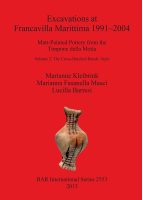Description
BOOK DESCRIPTION
This 2nd volume of the Oenotrian matt-painted pottery found during the excavations at Francavilla Marittima (Calabria) in the sanctuary on top of the Timpone della Motta and in the dwellings lower down the hill presents a decorative tradition labelled the 'Cross-hatching Bands Style'. An earlier BAR volume (S2423) treated the 'Undulating Bands Style' and further BAR volumes on the 'Fringes', 'Miniature' and 'Red-and-Black' Styles will hopefully follow). The books reflect the views of Prof. Douwe Yntema, in that matt-painted ceramics indicate one of the major starting points for investigations into the native societies of southern Italy and should merit closer study.
Marianne Kleibrink studied Archaeology and Art History at Leiden University in the 1960s. Her doctoral thesis, judged a cum laude, was on the ancient-gem collection of The Hagues Coin Cabinet. She was conservator of ancient coins and assistant lecturer at Leiden University, and in 1976 was nominated the Chair of Classical Archaeology at Groningen University. She directed excavations at Satricum (Lazio) from 1979 to 1991, and from 1991 to 2004 at Francavilla Marittima (Calabria). Her publications comprise books and articles associated with the mentioned excavations and on engraved gems, ancient sculpture and the iconography of ancient myth.
REVIEW
'The comprehensive nature of the publication can only be described as exemplary and reminds us of the tremendous service to the discipline that is provided by the BAR series…In keeping with the nature of the volume, the treatment of each individual sherd is characterised by thoroughness. The decoration is extensively described and similar attention is devoted to the fabric and to manufacturing marks, where they exist. This is a level of detail that one rarely finds in pottery reports from excavations.’
Edward Herring, Ancient West and East, Volume 15, 2016











